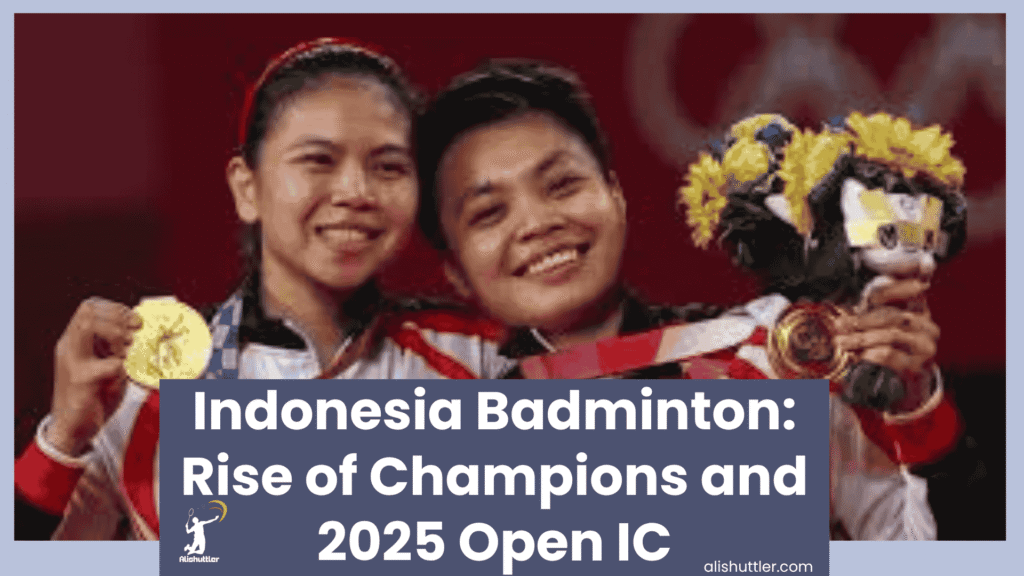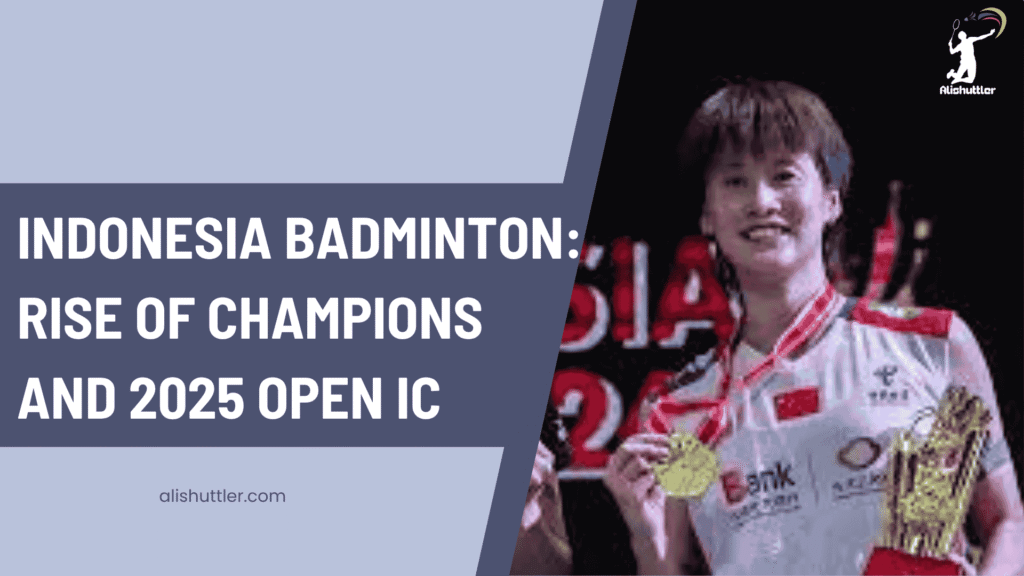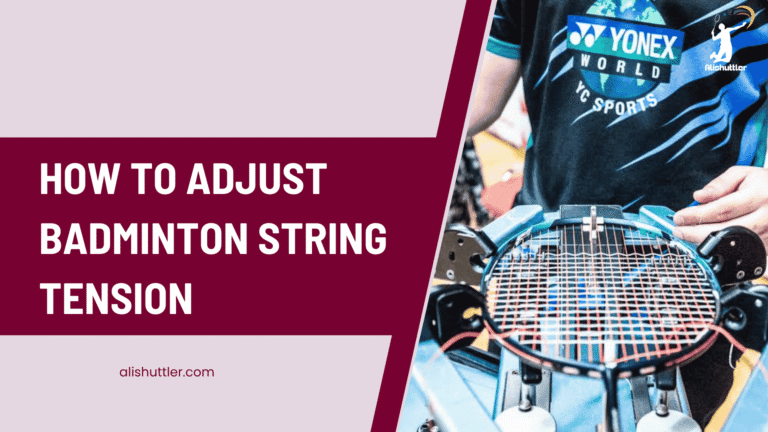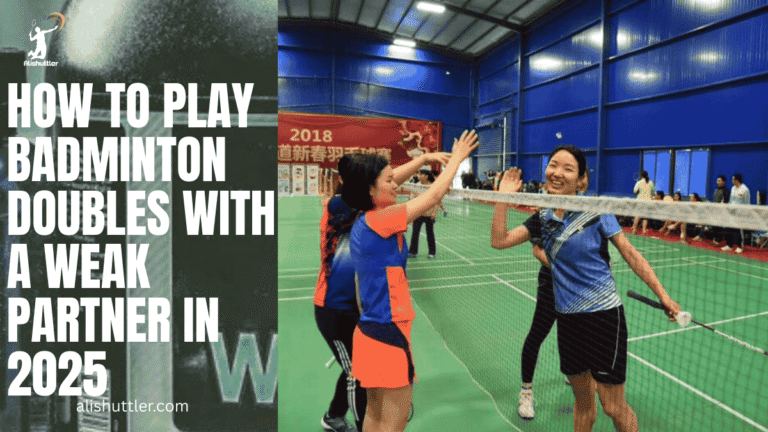Indonesia badminton is one of the most popular sports in the country, known for its strong tradition and top-ranked players. Many fans catch games in crowded arenas and support regional leagues.
The country has taken home medals at the Olympics and other global stages, displaying genuine prowess and breadth in the game. To find out more, the sections below spotlight top players, major victories, and how badminton influences culture and life on the ground.
Historical Dominance
Indonesia remains one of the most revered countries in world badminton, particularly through its national badminton team! Its indonesian badminton players have won international acclaim for decades, influencing the world’s sports landscape. From humble roots, Indonesian badminton has blossomed into a symbol of pride and solidarity, with a legacy that extends well beyond its shores.
1. Early Beginnings
Badminton initially arrived in Indonesia during the colonial period via European channels, but it soon caught on with the indigenous population. By the 1930s, casual games had propagated in places like Jakarta and Surabaya. The establishment of the Indonesian Badminton Association (PBSI) in 1951 was a significant milestone. PBSI strived to structure the sport, define regulations and assist players.
Early tournaments like the All-Indonesia Championships became vital proving grounds, spawning early stars like Ferry Sonneville. These foundations enabled Indonesia to develop a formidable talent pipeline and attract global focus by the mid-20th century.
2. Golden Era
The 1990s and early 2000s are known as Indonesia’s golden era in badminton, particularly for the Indonesian national badminton team. During this period, the national team ruled the world stage, particularly the Thomas Cup and All England Open. Men’s doubles titles were won by famous Indonesian badminton players like Rexy Mainaky and Ricky Subagja, while mixed and singles players starred at competitions such as the World Championships.
The game was taking over at home, packing stadiums and inspiring kids to play in the streets every afternoon. This era created an environment of winning, where youth players witnessed routes to international accomplishment, including the success of the Indonesian badminton players on the global stage. The impetus from this period drove investment in youth development programs and infrastructure, ensuring a continuous stream of elite players.

The successes of this period extended Indonesia’s dominance in Southeast Asia, motivating its neighbors to enhance their badminton programs in response to the Indonesian team’s achievements.
3. Legendary Figures
Susi Susanti, Indonesia’s first gold medalist, is a beacon of persistence. Taufik Hidayat’s genius and style mesmerized fans globally, boasting a 2004 Olympic gold and several Asian Games championships. These legends, along with the likes of Liem Swie King and Alan Budikusuma, were idols to aspiring players.
Their tales are told in schools and clubs, inspiring the next generation. Their influence transcends trophies; their principles and diligence continue to inspire the spirit of Indonesian badminton. Millions of today’s players idolize these legends.
4. Olympic Glory
Indonesia’s maiden badminton gold arrived at Barcelona 1992, courtesy of Susi Susanti. Since then, the country has been hoisting medals left and right to sustain its Olympic supremacy. Every victory is celebrated across the nation and intensifies national pride.
Preparation for these victories consists of years of dedicated training, frequently at national training centers and under close supervision. Olympic glory has assisted in making badminton a priority for sports funding and youth development in Indonesia. Olympic medals keep the sport in the headlines and stoke new ambition.
5. Cultural Fabric
Badminton is ingrained in everyday life in Indonesia. Courts pack up in city neighborhoods and countryside towns alike. The game unites us at carnivals and 4th of July celebrations. It connects regions and backgrounds to foster a common pride.
For kids and teens, playing badminton is a social activity and a form of exercise.
The Talent Factory
Indonesia’s badminton excellence is not an accident, as the country has developed a robust system for nurturing talent within the national badminton team. Training centers, clubs, and local programs work together to identify and coach promising Indonesian badminton players from a young age, ensuring that Indonesia continues to produce world-class athletes season after season.
Pelatnas System
Pelatnas — an acronym of “Pemusatan Latihan Nasional” — is Indonesia’s national badminton training camp, crucial for the indonesian badminton players. It operates under the Badminton Association of Indonesia (PBSI) and serves as the centralized base for recruiting and developing the country’s elite players, including famous Indonesian badminton players. At Pelatnas, athletes undergo rigorous daily schedules centered around enhancing fitness, skills, and mental acuity, preparing them for international badminton team competitions.
At Pelatnas, athletes undergo rigorous daily schedules centered around enhancing fitness, skills, and mental acuity. The program provides them with nutritionists, sports psychologists, and medical care, establishing a safety net that makes players healthy and ready for hard encounters.
Coaches and athletes bond, establishing trust and a joint competitive spirit that is essential for success in competitions like the Asian Games. The dedication shown at Pelatnas not only enhances individual skills but also strengthens the Indonesian national badminton team as a whole, preparing them for future challenges on the world stage.
Club Culture
Badminton clubs litter Indonesia—from the big cities to the small towns. For lots of players, these clubs are their first real step — providing regular practice, coaching, and belonging. Clubs such as PB Djarum and Jaya Raya mould raw talent, scouting kids as young as seven or eight.
Clubs facilitate players participation in local and regional tournaments, which are crucial in developing experience and confidence. It’s not just about the prize—these competitions provide a platform to build and develop in REAL competitions. Several clubs organize their own events as well, attracting audiences and enhancing the exposure of the sport.
The club community is important as well. Kids and parents alike bond, swapping tips and support. This support makes more kids persevere in the sport, even when training becomes hard or success doesn’t arrive immediately.
Coaching Philosophy
Coaches in Indonesia focus on simple tactics: strong basics, smart play, and building mental strength. Training isn’t solely focused on shuttle strikes—it’s about training yourself to read opponents, remain calm under pressure, and recover from adversity. Coaches emphasize grit and concentration when the match gets close.
Most elite coaches are former players who have been there and know what it takes to win. They blend tried-and-true drills with new concepts, such as employing video analysis to research opponents or rotating practice sessions to keep players on their toes.
By combining experience with new techniques, Indonesian coaches assist players in staying current with the rapidly evolving world of international badminton.
Grassroots Initiatives
Grassroots programs get kids in schools and neighborhoods, ensuring badminton is accessible to everyone. These initiatives assist in identifying latent ability at an early stage.
Free clinics and school tournaments provide every kid an opportunity to play and develop. This broad appeal creates a foundation for the future.
Young players get coaching and equipment, which eliminates obstacles for parents. More kids playing, more opportunities to discover the next top star.
Modern Challenges
Indonesia’s badminton bubble has a few holes that threaten to deflate its expansion and put strain on its accomplishments, especially for the Indonesian national badminton team. Funding, infrastructure, and talent regeneration are all key areas that define the future of Indonesian badminton players.
Funding
This funding is crucial as it covers training, travel, and equipment for the indonesia national badminton team. It also includes entry fees to international tournaments, which can be quite expensive for teams and players, including indonesian badminton players. Sponsors and government support are essential to fill athlete requirements.
Financing holes still exist, especially for new stars and local teams. Without consistent financing, players might not receive sufficient attention or quality training. This can stifle their abilities and prevent new talent from achieving world class status.
To address funding concerns, numerous advocate for wider sponsorship deals, crowd-sourced campaigns, and a more engaged role from local governments. More grants or incentives for private investment might make a system more sustainable.
Infrastructure
Indonesia has a few really good training centers in the larger cities, but for the most part, regions have fewer courts, antiquated equipment, and less access to good coaches. For youth athletes, that translates into less opportunities to compete or practice near home.
Preparing top players requires updated courts, secure playgrounds and quality indoor venues. Without them, even gifted athletes flounder toward their potential. Numerous local clubs do so with shared or converted premises impacting performance.
Having access to good facilities counts at all levels. Schools and community centers with nicer courts can get more kids on the courts. For professional players, elite equipment and support services, like physio and recovery rooms, help keep them on the edge.
A handful of provinces have begun to invest in new facilities. Joint ventures between sports bodies and private sectors are spreading new training centres and events to more regions. These are just early steps, though, and good infrastructure is slow to propagate across the country.
Regeneration
Keeping Indonesia strong in badminton lies in discovering and supporting the next generation of players. Without a pipeline of youth, the nation’s dominance in the sport could wane.
Talent scouts and regular junior tournaments and coaching programs spot the promising players. A few clubs join up with schools to promote participation among the youth. This contributes to diversifying the talent pool and discovering gifted athletes of various heritages.
Schools are important. Some run after-school lessons or badminton teams. Community groups usually provide free introductory coaching, so kids from every income level can get engaged. Still, not every area has the same resources or experienced personnel.
To maintain the system running, clubs and schools require continuous assistance. That could translate to increased resources, quality coaching materials or consistent access to good courts. Without these, it’s difficult to keep young players interested in the long-haul.
Contemporary Stars
Indonesia has a very deep badminton pool, evidenced by the emergence of the indonesian badminton players who consistently perform at high levels. Their abilities and game strategies not only maintain the national badminton team’s presence in the limelight but also influence play styles internationally.

Men’s Singles
Jonatan Christie and Anthony Sinisuka Ginting are Indonesia’s current men’s singles flag bearers. Both have cracked the world’s top ten and are renowned for their grit in big matches. Every season, they feature in tournaments such as the All England Open and the BWF World Tour, consistently progressing to the late stages.
Christie, who took gold at the 2018 Asian Games, is known for his tenacious defense and stoic patience on court. Ginting delivers pace and incisive strikes that have resulted in him defeating seeded players. The men’s singles field is brutal, with rivals from Japan, Denmark and China, but Indonesia players are still in the hunt for big titles.
Men’s Doubles
Indonesia’s top men’s doubles teams, including Marcus Fernaldi Gideon and Kevin Sanjaya Sukamuljo, have led the charge. Dubbed “the Minions” due to their speed, the duo have been world number ones for a few years now and have claimed over fifteen BWF World Tour titles as a pair. Their chemistry and speed of play make them difficult to outperform, compelling the rest to keep up.
Ahsan and Setiawan, “the Daddies”, provide a contrast with their slick, cool composed style and mature approach. They’ve won top tournaments like the All England and World Championships. These pairs practice reflex drills, shot variation, and split second co-ordination, proving that in men’s doubles strong teamwork is the name of the game.
Mixed Doubles
Mixed doubles is at the heart of Indonesia’s badminton tale. Big name pairs like Praveen Jordan and Melati Daeva Oktavianti took out major events, including the 2020 All England. They combine their power from the backcourt with incisive net play, a combination that demonstrates the depth of Indonesian talent.
This class required men and women alike to labor as one. Duos have to accurately read one another and switch roles quick. Mixed doubles is popular now because it showcases the flexibility and agility of the Indonesian shuttlers. Their dominance in mixed play demonstrates how the nation cultivates talent across all positions.
Indonesia Open
Not only is the Indonesia Open one of the world’s premier badminton tournaments, it attracts fans and players from throughout the world, with its location on the calendar being a highlight for both competitions and fans. It provides a showcase for top-level competition, frequently establishing the battleground for some of the sport’s finest clashes.
Its history and prestige have helped define Indonesia’s reputation as a badminton epicenter.
Super 1000
Indonesia Open (Super 1000) It is the top tier for regular BWF World Tour tournaments. Few tournaments have this distinction, so the Indonesia Open is one of the key destinations for players pursuing points and prestige.
| Tournament Level | Prize Money (USD) | Global Ranking Points | Typical Draw Size | Notable Winners |
|---|---|---|---|---|
| Super 1000 | 1,250,000+ | 12,000 (Winner) | 32 (per event) | Kento Momota, Tai Tzu-ying, Viktor Axelsen |
Super 1000 status attracts a violent field, featuring the world’s top 10 players in all categories. With the pressure mounting, a victory here translates to a huge jump in the rankings and a slice of a huge prize fund.
It breeds competitive match play, where upsets and down-to-the-wire tiebreakers are the norm. With the world’s attention on Jakarta for this event, Indonesian badminton’s global profile shines brighter than ever.
Istora’s Roar
The Istora Gelora Bung Karno is the epicenter of the action. Famous for its fervent energy and deafening non-stop noise at matches, packed to the rafters, the crowd generates a buzz that is difficult to find elsewhere in the badminton universe.
The design of Istora brings fans near the court, making them part of the action. Its size means lots more fans can watch live, and the sound reverberates around the arena, amplifying the tension and excitement.
For players, those roars and chants can provide an additional boost, particularly for the home favorites. A number of Indonesian players attribute the crowd’s backing to some of their greatest matches. Istora is not just a stadium, it’s a national monument and reflection of Indonesia’s love affair with badminton.
Tournament Excitement
Fans look forward to the Indonesia Open each year. Tickets often sell out within days.
Players know the stakes and prepare for fierce battles. Each event delivers new narratives and memories that resonate for supporters.
The Soul of Badminton
Badminton transcends sport in Indonesia, uniting the indonesian badminton players and fans from diverse origins. It molds patriotism and resonates deeply in everyday existence, connecting families, friends, and even strangers as they come together to play, spectate, or cheer as one.
National Pride
For so many Indonesians, badminton is not just a pastime; it is a source of national pride, especially when the indonesia national badminton team achieves success on the world stage. Every victory, from Olympic golds to All England titles, generates a collective pride. When a top player stands on the podium, the national anthem plays, and millions watch with pride back home. These moments unite us across islands and cultures, all with something to celebrate.
The sport evokes passion, particularly during high-stakes tournaments. In big competitions, streets clear as families gather around TVs, reminiscing about when Indonesia won the Thomas Cup or when famous Indonesian badminton players like Susi Susanti and Taufik Hidayat brought home medals. These triumphs not only demonstrate what is possible for Indonesians but also ignite aspirations for the future generation of badminton players.
Badminton triumphs inspire in hard times. It makes them dream and motivates many kids to grind, like their idols. For others, these victories are a testament to grit and collaboration. They allowed Indonesia to hold its head high on the world stage, demonstrating that a little country can leave a big footprint in the world of sport.
Community Spirit
Local clubs and small courts are everywhere in Indonesia. In cities and villages, people come to play, train, or watch. It’s this powerful community web that keeps the game vibrant. Badminton unites the young and the old, the male and the female, the common and the not-so-commoner.
A lot of clubs operate junior programs for boys and girls. Even schools and youth centers have tournaments to get more kids involved. Others have families who step up to the courts at home or at public ones, playing the game into life.
Clubs, such as PB Djarum or Jaya Raya, back players with coaching and equipment. They even have community events for new players. These communities forge powerful bonds and maintain people bonded by sport.
Community spirit propels the game. That feeling of belonging keeps clubs alive and players in the game for years.
Future Aspirations
Indonesia’s badminton community, including the Indonesian badminton players, aims to stay number one in the world. The Indonesian Badminton Association, PBSI, typically sets clear goals for the upcoming Olympics and World Championships. They focus on identifying emerging talent and assisting youngsters with advanced training and resources, while also turning their attention to coaching and sports science to adapt to the sport’s evolution.

Innovation is key for the Indonesian national badminton team. Most clubs experiment with new drills, research the latest strategies, and utilize digital training aids. This approach keeps players engaged and ready for fresh challenges.
Young players admire famous Indonesian badminton players but are eager to carve their own niche. With support from mentors and clubs, this new generation aims to uphold Indonesia’s badminton tradition for many years to come.
Final Thoughts
Indonesia is a powerhouse in world badminton. Local boys keep the ball rollin’, with their talent and tenacity. Young stars emerge every year, pursuing victories both at home and overseas. Indonesia Open attracts big names and huge audiences, demonstrating the sport’s profound heritage. Families play in city gyms, parks, and small towns.
Badminton defines life and unites us. The game encounters new challenges, but the motivation to triumph remains distinct and strong. Fans still root, and kids still dream big. To dig in deeper or tell your own badminton tale, get in touch or jump into the next local match. There is always room for new voices and new energy in the world of Indonesia badminton.
Frequently Asked Questions
Why is Indonesia famous in badminton?
Indonesia has a great heritage in badminton, highlighted by its national badminton team, which has produced world champions and Olympic gold medalists. The country’s famous Indonesian badminton players have consistently put Indonesia at the forefront of the sport globally.
What is the Indonesia Open in badminton?
The Indonesia Open is a top-notch international badminton tournament, attracting the best Indonesian badminton players and others from around the globe. It is a key part of the Badminton World Federation (BWF) World Tour, enjoying great prestige in world badminton.
Who are some famous Indonesian badminton players?
Legendary Indonesian badminton players, such as Rudy Hartono, Susi Susanti, Taufik Hidayat, and Kevin Sanjaya Sukamuljo, have bagged numerous titles, making them famous Indonesian badminton players celebrated for their remarkable accomplishments.
How does Indonesia develop badminton talent?
Indonesia cultivates badminton talent through local clubs, junior academies, and national training centers, producing numerous skilled Indonesian badminton players. These young athletes, guided by experts, are prepared to compete internationally, including representing the Indonesia national badminton team.
What challenges does Indonesian badminton face today?
Contemporary obstacles for the Indonesia national badminton team are formidable rivals from other countries, budget restrictions, and the need to stay up to speed with coaching technology, which demands constant adjustment and creativity.
Why is badminton important to Indonesian culture?
It unites communities and stirs up national pride, especially during global competitions like the World Badminton Championships, where the Indonesia national badminton team shines.
How successful is Indonesia at the Olympics in badminton?
It has secured several gold medals, contributing to the reputation of the Indonesian national badminton team as one of the top badminton nations by the IOC.






